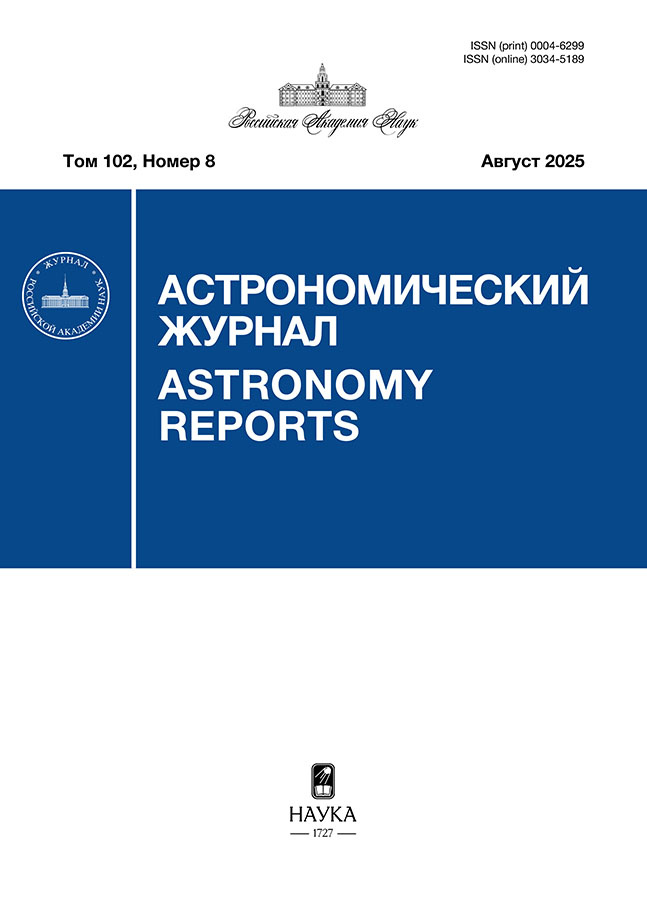Бессиловой магнитный жгут с высокой плотностью тока на оси
- Авторы: Соловьев А.А.1
-
Учреждения:
- Главная (Пулковская) астрономическая обсерватория РАН
- Выпуск: Том 101, № 6 (2024)
- Страницы: 565-574
- Раздел: СТАТЬИ
- URL: https://modernonco.orscience.ru/0004-6299/article/view/647642
- DOI: https://doi.org/10.31857/S0004629924060072
- EDN: https://elibrary.ru/JMGMVF
- ID: 647642
Цитировать
Полный текст
Аннотация
Представлена новая модель бессилового магнитного жгута с большой плотностью электрического тока на оси. Общее свойство осесимметричных бессиловых магнитных жгутов состоит в том, что с выходом вершины петли-жгута в корону внешнее давление, удерживающее его от бокового расширения, неуклонно падает, и при некотором критическом его уменьшении продольное магнитное поле жгута обращается в нуль на поверхности смены знака электрического тока (current inversion surface — CIS). При этом бессиловой параметр α(r) и азимутальный электрический ток испытывают на этой поверхности разрыв второго рода, так что в окрестности CIS их значения начинают неограниченно расти (по модулю). Токовая (дрейфовая) скорость электронов здесь неизбежно превысит скорость ионного звука. Это служит триггером к разогреву неизотермической плазмы (так что будет: Te >> Ti) и возбуждению плазменной ионно-звуковой неустойчивости плазмы не только вблизи CIS, но и в центральной области жгута, где плотность тока особенно велика. Аномальное сопротивление плазмы ведет к быстрой диссипации магнитного поля и генерации супер-дрейсеровского электрического поля. Эффект Паркера (выравнивание, с некоторой задержкой, вращающего момента вдоль оси жгута за счет переноса азимутального поля в область энерговыделения) приводит к квазипериодическим пульсациям жесткого излучения вспышки и, в конечном итоге, обеспечивает вспышечное выделение заметной части всей свободной магнитной энергии, накопленной в жгуте.
Полный текст
Об авторах
А. А. Соловьев
Главная (Пулковская) астрономическая обсерватория РАН
Автор, ответственный за переписку.
Email: astrojourn@pran.ru
Россия, Санкт-Петербург
Список литературы
- A. A. Solov’ev, E. A. Kirichek, Monthly Not. Roy. Astron. Soc. 505, 3, 4406–4416 (2021).
- A. A. Solov’ev, Monthly Not. Roy. Astron. Soc. 515, 4, 4981–4989 (2022).
- A. A. Solov’ev, E. A. Kirichek, Astronomy Letters 49, 5, 256–268 (2023).
- A. A. Solov’ev, O. A. Korolkova, E. A. Kirichek, Geomagnetism and Aeronomy 63, 8, 10–25 (2023).
- G.D. Fleishman, D. Gary, B. Chen, et al., Science 367, 278–280 (2020).
- G. D. Fleishman, G. M. Nita, M. Gelu, B. Chen, Nature 606, 674–677 (2022).
- Л. А. Арцимович, Р. З. Сагдеев Физика плазмы для физиков (М.: Атомиздат, 1979).
- V. M. Tomozov Solar activity and solar-terrestrial relations (85–89, 1976).
- A. T. Altyntsev, V. I. Krasov, V. M. Tomozov Vneatmos. Issled. aktiv.oblastej na Solntse (Moskva, Nauka, 132–135, 1976).
- E. N. Parker Cosmical Magnetic Fields (Clarendon Press, Oxford, Part 1, 1979).
- E. N. Parker Conversations on Electric and Magnetic Field in the Cosmos (Princeton Univ. Press, Princeton, NJ, 2007).
- T. Gold, F. Hoyle, Monthly Not. Roy. Astron. Soc. 120, 89–105 (1960).
- В. Д. Шафранов Вопросы теории плазмы (М. Атомиздат. вып. 2, 92–132. 1962).
- В. Ф. Мельников, И. А. Бакунина и др. Доклад на 19-й конференции «Физика плазмы в солнечной системе» (М., ИКИ РАН, 2024).
- S. Krucker, M. Battaglia, P. J. Cargill, et al., Astron. and Astrophys. Rev. 16, 155–208 (2008).
Дополнительные файлы

















